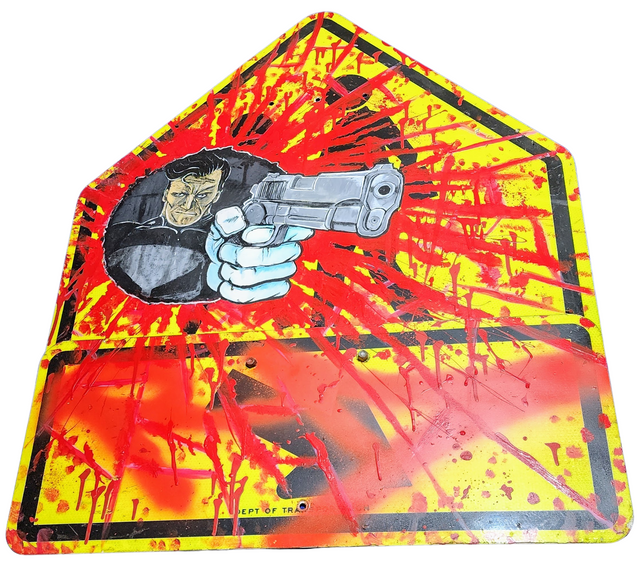
Street Signs
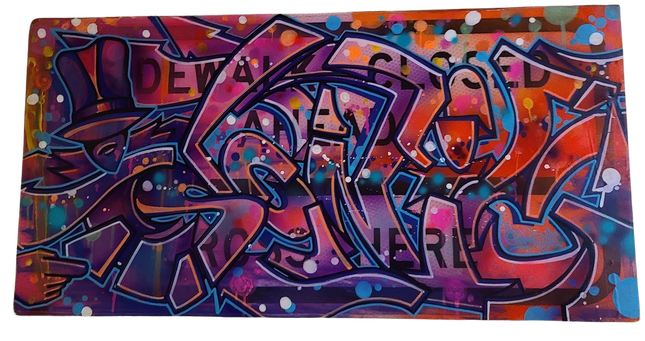
Sonic Bad Sidewalk Closed Wood Original Mixed Media Street Sign Painting by Sonic Bad
Sidewalk Closed- Wood Original Mixed Media Graffiti Artist Modern Pop Art on Real Street Sign by Sonic Bad. 2018 Signed Original Spray Paint & Mixed Media on Wooden New York City NYC Sidewalk Closed Vintage Sign Artwork Size 21.5x11.5 The Artistic Alchemy of Sonic Bad: Reimagining Public Notices Sonic Bad's 'Sidewalk Closed - Wood' is an exemplary showcase of modern pop art manifested through the lens of street sensibilities and graffiti culture. Created in 2018, this signed original piece is a vibrant declaration of the transformative power inherent in street pop art and graffiti artwork. The fusion of spray paint and mixed media on a wooden canvas that once served as a New York City sidewalk sign encapsulates the artist's penchant for repurposing the functional into the visually extraordinary. Technique and Symbolism in Sonic Bad's Work The artwork, measuring 21.5x11.5 inches, is a testament to Sonic Bad's mastery over mixed media. The piece harmoniously integrates the textures of wood with the fluidity of spray paint, achieving a layered effect that adds depth and complexity to the composition. The choice of a 'Sidewalk Closed' sign is significant; it takes an object that signifies obstruction and transforms it into a portal of creative expression, thus inviting reflection on the role of public space and the rules that govern it. Sonic Bad's approach to the sign is subversive yet playful, disrupting its original intent and engaging viewers in a dialogue about the accessibility of art and public communication. The vibrant color palette and intricate design work serve to capture the gaze and provoke thought, a hallmark of effective street pop art. The way the letterforms and characters are interwoven with the sign's warning embodies a kind of artistic alchemy, turning the mundane into the magical. Impact and Reception of Sonic Bad's Street Sign Artwork The 'Sidewalk Closed - Wood' piece by Sonic Bad does not simply occupy space; it commands attention and interaction. Its existence in a gallery or a private collection continues to challenge perceptions of street art's place within the art world hierarchy. Sonic Bad's work is celebrated for its unabashed embrace of street art aesthetics while simultaneously pushing the boundaries of what such art can communicate and how it is perceived. Sonic Bad, an artist who remains an enigmatic figure in the graffiti art scene, utilizes anonymity as a tool, allowing the work to speak for itself. The artist's contributions to street pop art are measured by the vibrancy of the pieces left in public view and the conversations they ignite. The influence of such work extends beyond the streets, infiltrating popular culture and challenging traditional art's status quo. Sonic Bad's Legacy in Street Pop Art Sonic Bad's 'Sidewalk Closed - Wood' is not merely a piece of reclaimed street furniture but a microcosm of street art's potential to redefine the aesthetics of urban living. This work stands as a cultural artifact, a piece of New York City's story told through the eyes of a street artist. Sonic Bad's legacy is enshrined in every color splash and line twist, a testament to the enduring allure and social commentary of street pop art and graffiti artwork. The legacy of artists like Sonic Bad is often measured by the endurance of their work in the public imagination and their ability to inspire future generations of artists. By turning a sidewalk sign into a canvas, Sonic Bad has not only altered the sign's trajectory but also contributed to the narrative of street art as a form of modern pop art. This piece will continue to be a point of reference for discussions about the interplay between public space and artistic freedom, embodying the spirit of street art that refuses to be sidelined.
$2,000.00
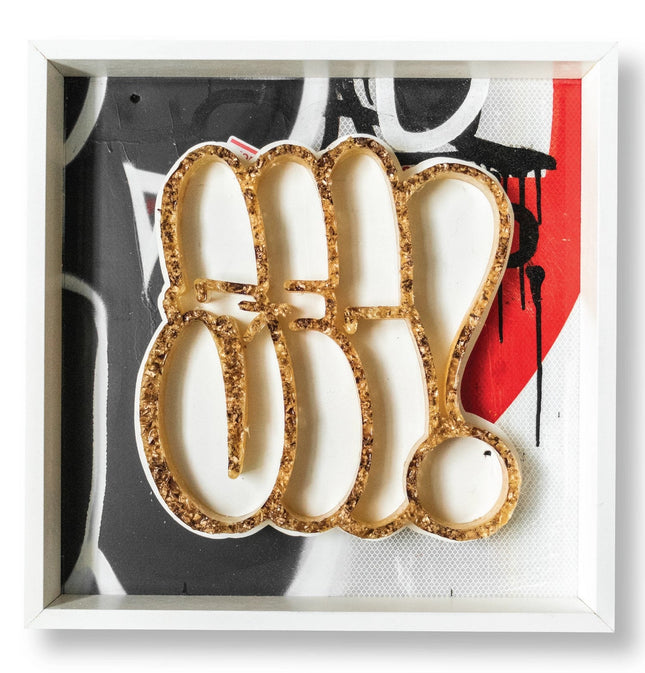
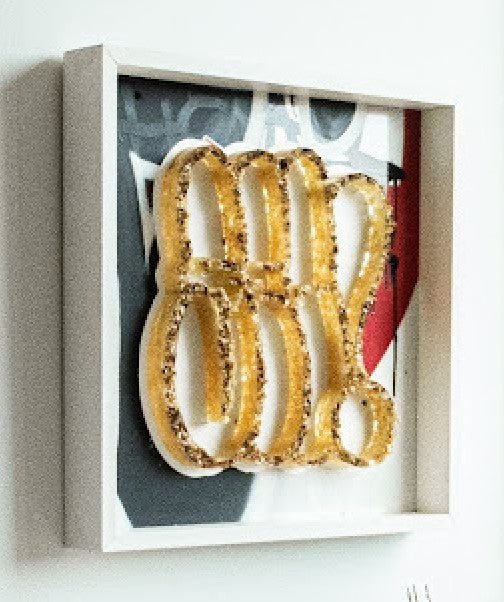
Sechor Street Shatter Street Sign Graffiti Painting by Sechor
Street Shatter Art Epoxy Wood Mixed Media on Street Signed Framed Sculpture/Painting Artwork by street pop culture artist Sechor. 2021 Signed Artwork Size 20x20 Ready To Hang Framed Original Mixed Media Wall Art Sculpture made of epoxy mixed with wood chips on a real "Do Not Enter" street sign in a handmade frame, ready to hang.
$1,545.00
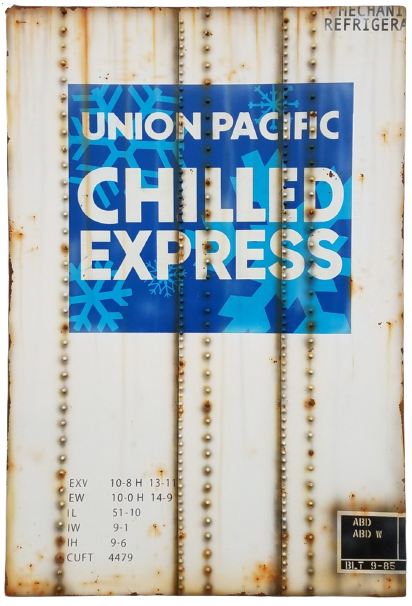
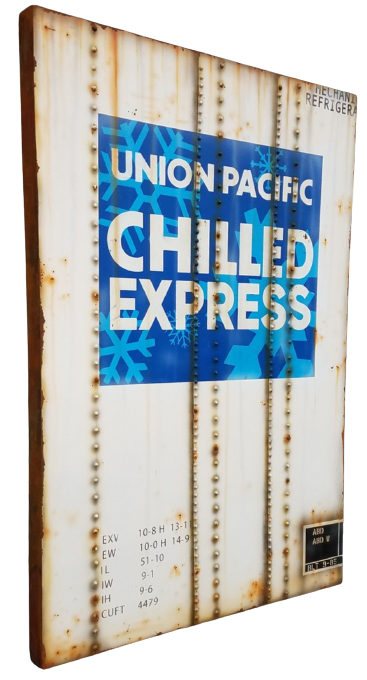
Lyric One Union Pacific Chilled Express Street Sign Original Acrylic Painting by Lyric One
Union Pacific Chilled Express Original One of a Kind Acrylic Paint Painting Artwork on Studded Distressed Cradled Wood by Popular Street Graffiti Artist Lyric One. 2019 Signed Hand-Painted Ready To Hang Original Acrylic Paint Wood Panel With Realistic Raised Rivets Size: 24 x 36 Inches Release: August 15, 2019 Capturing the Essence of Transient Motion in Street Art The 'Union Pacific Chilled Express' is a striking original acrylic painting by the famous street graffiti artist Lyric One. This 2019 hand-painted piece on a studded distressed cradled wood panel, with realistic raised rivets, measuring 24 x 36 inches, embodies the fusion of street pop art and graffiti artwork. It resonates with the movement and commercial vibrancy that are the lifeblood of the railroads, an homage to the transient nature of both freight and art. Industrial Narratives in Lyric One's Work Lyric One's artistic endeavor into the world of transportation and industry is encapsulated in this significant work. The subject matter – a Union Pacific refrigerator car used for transporting perishable goods across vast distances – is not a common muse for artists. However, Lyric One elevates this everyday industrial object to a piece of art, meticulously capturing the textures and surfaces that tell a story of travel, trade, and the passage of time. The artwork, signed and ready to hang, was released on August 15, 2019. It reflects the artist's deft ability to translate street pop art's ethos onto various canvases. The choice of distressed wood and the attention to detail, such as the raised rivets, are reminiscent of the textures found in urban environments. These rivets add a tactile element to the piece and echo the industrial nature of rail transport – each one could represent the countless connections and junctions found along the rail networks. Symbolism and Aesthetics in Graffiti Artwork In 'Union Pacific Chilled Express,' the contrast between the practical function of the chilled express service and the vibrant expression of graffiti art is striking. The bold, ice-blue lettering against the stark white background captures the viewer's attention, drawing them into a world where the industrial and the artistic collide. Snowflake motifs not only signify the refrigeration aspect but also add an element of fragility, a subtle nod to the impermanence often a theme in street art and the world of commerce. Lyric One's work is a testament to the dynamism of street pop art. With each brush stroke on the cradled wood, the artist brings to life the hum of the railway lines, the chill of the cargo holds, and the omnipresence of industry in our daily lives. The artwork is not just a static piece to be admired; it is an active participant in the dialogue about the role of industry in society and the omnipotent influence of commerce in our visual culture. This piece by Lyric One reminds us that street pop art and graffiti artwork are not confined to walls and alleyways but are dynamic forms that can transform any surface into a narrative. The 'Union Pacific Chilled Express celebrates this versatility and the ability of street artists to capture the essence of motion, industry, and life's transient nature in their work.
$2,500.00






